News topics
Monthly Newsletters
// //// //// Online Booking //
// //// // // // // // //
For group bookings please contact
017687 77246 or
contact@derwentwater.org
Jenkins family gathering, October 2017
September 2016
.jpg)
Welcome to our mothly newsletter, packed with photos of moths from around the hostel. Unlike the Victorians, Alex Helliwell, our staff member and moth photographer and researcher, has not pinned them to a board for display. However, he has tried to photograph and identify each moth, allowing it to live in the process.
William Henry Fox Talbot, the Victorian photography pioneer and inventor, rented Barrow House in 1850 and 1851. Several decades later, the self-styled Professor of Adventure, Millican Dalton, who lived in a Borrowdale cave during the winters of the Second World War, used photograph postcards to publicise his camping programmes and 'hairbreadth adventures', and was an early pioneer of rock climbing photography. Oughterside School followed in their footsteps, with several camera clicks along the way. Thank you to Southampton Scouts for sharing their photos and adventures with us too.
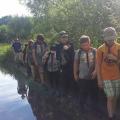
To Derwentwater Independent Hostel,
First off I would like to send a huge thank you from me and all the rest of the 26th Southampton Scout group. We had a phenomenal summer camp: everyone had a great time. I thought it would be nice to give you an overview of the shenanigans we got up to.
Sunday – the long drive
Bleary eyed, the scouts clambered into the minibus for a joyful 8 hours of travel. We started our long journey snaking up the country, the scouts having to endure awful jokes and an even worse taste in music. Eventually we arrived at your hostel. Excitedly, the scouts began to explore, thrilled to find a picturesque waterfall just outside.
Monday – day on the water
Our first day was spent on the water: canoeing in the morning and raft building after lunch. Everyone got a good soaking as the scouts tried to jump from one raft to another. As if that was not enough, we took the scouts on an evening hike, giving us a picturesque sunset from the fells behind the hostel.
Tuesday – the first hike
We left from the hostel, heading up the fells, over to Keswick, then back along the lake, to finally reach the hostel tired but satisfied: this was a longer and more challenging hike than most of the scouts had done before, and they all seemed to have a great time. The scouts even had a chance to practice first aid as two of the leaders had ‘mystery accidents’ at the same time.
Wednesday – climbing and Keswick
In the morning it was rock climbing. Prior to the camp none of the scouts had climbed a natural rock face, and everyone took part with gusto: even the leaders joined in, and it is definitely something to do again. In the afternoon the scouts had a chance to explore Keswick (and stock up on sweets). After a nice walk we had fish and chips before the walk back to the hostel, negotiating a big puddle on the way (see photo above)!
Thursday – the second hike and camp cooking competition
The second hike was slightly shorter but a great opportunity for the scouts to brush up on their map reading skills. It was a high point for me seeing the scouts get the hand of map reading and navigating with a compass. We had fun crossing a washed away bridge. In the evening we had the cooking contest, where the scouts started preparing their culinary delights. Huge thanks to the hostel team, who risked life and limb in sampling the scouts’ cooking. The day concluded with a game of bingo, with the worst puns of the holiday.
Friday – ghyll scrambling and camp fire
As our camp came to a close we had the highlight: ghyll scrambling, something none of the scouts had ever done before. All that could be heard were the shouts of ‘keep er gowin’ as the scouts raced down the stream, diving off waterfalls. After the scouts dried off we started building the bonfire, cooking dinner, then had a night of camp fire songs. We took a small sample of the ashes with us to act as a memory of the camp.
Saturday - the long drive home
Tired and happy we packed up and started our long journey home. We piled into the minibus and within minutes all but the driver fell asleep (including me).
To finish off: a huge thank you from all of us at the 26th - you made us feel very welcome and we all had a great time. You definitely helped give all of the scouts some great memories for life.
Mark Pickering, Scout Leader 26th Southampton Scouts
.jpg)
A report by Alex Helliwell (Hostel Assistant).
Every month dozens of guests succeed in staying here overnight without paying a shilling. They sneak in through the windows at night and tend to lurk silently around the toilet and shower areas, for some depraved reason known only to themselves. Since the end of May this year, over 80 species of this criminal group have been identified. Here are some that have been caught by our security cameras over the last few months, with the one pictured above our 'Moth of the Month'… the Twenty-plume Moth (deceptively dull and uninspiring at first sight, but look closely and see that its unusual wings are formed from 24 tiny feather-like structures).
Information in photo captions sourced from www.ukmoths.org.uk. All photos by Alex Helliwell.
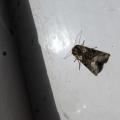
The Spectacle moth has raised tufts of scales on the thorax which resemble a pair of spectacles when viewed from the front.The Spectacle moth has raised tufts of scales on the thorax which resemble a pair of spectacles when viewed from the front.
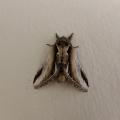
The Lesser Swallow Prominent has a more distinct white wedge at the tornus of the forewing than the Swallow Prominent. The larvae feed on birch.
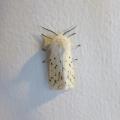
The White Ermine. There is considerable variation in the degree of black speckling in this species.
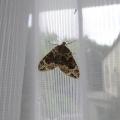
There is generally just one generation of Small Phoenix per year in the north.
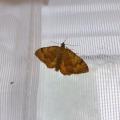
The Yellow Shell is a very variable species, with a preference for damper areas. Smaller, darker ones frequent rocky places in N. Scotland and Ireland.
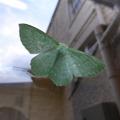
The largest of the 'Emeralds', caught on camera mid-flight at the back of the hostel. It flies at night in June and July, when it is easily attracted by light.

The July Highflyer is a very variable species, both in markings as well as colour, with some showing a distinct green colour, others reddish brown. Prefers hedgerows and woodland margins.

The Clouded Border is a delicate moth. Natural flight time at night. Black and white markings show considerable variation in the wild.

The Angle Shades is a highly distinctive and unusual moth, which nests with its wings folded longitudinally, looking very much like a withered autumn leaf. The species is also a common migrant and can be found in large numbers at coastal locations (waiting for the ferry?!).
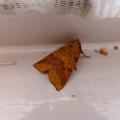
The Pink-barred Sallow is a widespread and fairly common species over much of the British Isles, frequenting mainly damp woodland and marshy areas. It will visit sugar as well as artificial light.

The Green-brindled crescent is an autumn species, flying from September to November, and fairly common throughout Britain. Althouth superficially a dull brown species, the typical form of this moth has patches of metallic green scales, giving it a sheen in the correct light.
If you would like a full list of the moths seen so far this year at the hostel, please emailreception@derwentwater.org.
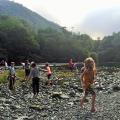
‘Don’t waste worrds!’ Can you find this engraving, with its deliberately rolled ‘r’s, in the upper cave on the eastern side of Castle Crag? 24 Oughterside School children can!
Shortly after our descent from the caves (former slate quarries), on the path to Rosthwaite, we saved our words, suddenly silent in the gaze of a pale brown deer. It was one of the louder children who spotted the deer, but he stopped, transfixed, gesturing and whispering to the rest of us, ‘there, in the long grass, there it is’. The deer stared at us, unmoving for several minutes, and we stared back until finally it turned, unconcernedly, and sprang lightly towards the river, followed by a couple more.
We continued quietly along the path, looking back at Castle Crag, and standing to one side as a farmer on a quad bike led some pink-dyed rams to a field. Our walk finished in Rosthwaite, where we refreshed ourselves and met the school bus. The bus driver had never been to Rosthwaite, so there was something new for him too.
Tired out, but happy, the children returned to school, full of tales of inventors, explorers, and pioneers, as well as their own adventures.
The one night stay, part-funded with a grant from the hostel, focused on the characters of William Henry Fox Talbot (inventor and pioneer of early photographic techniques), who lived at Barrow House in 1850 and 1851, and Millican Dalton, the self-styled ‘Professor of Adventure’ who lived in a cave on the side of Castle Crag (for several months of the year, including the winters of 1940 and 41), led pioneering rock climbs and other ‘hairbreadth adventures’, and claimed to be the inventor of shorts!
It was lovely to see some familiar faces when the group arrived (Oughterside have been on two previous occasions), and one boy even said ‘we’re home’. This year there were 24 pupils, from Year 3 to Year 6, and they really were a credit to the school. On the first day, despite wind and rain, we walked along to Platty+ for canoeing and stand-up paddle boarding. Platty+ were great, adapting the activities to suit the weather, and everyone had a wonderful time. The children also managed a glimpse of Castle Crag, sitting prettily in the middle of the valley, where Millican Dalton made his simple home.
The next day was warm and humid and completely still: not a breath of wind! After some playtime outside and a short map session in the dining room, we drew a collaborative picture of Millican Dalton and his cave on the whiteboard, with each child taking it in turns to come up and add a feature (for instance, a Tyrolean hat with heron’s feather, green corduroy shorts, hand-made boots without socks, a sewing machine, a campfire with a pan of roasted oats for porridge, a cup of strong syrupy coffee, and icicles hanging from the entrance of the cave!). Then we were ready to walk in his footsteps, exploring the route from Grange to Rosthwaite, with time to splash in the river and investigate the caves.
I really enjoyed my activities with Oughterside, and I was very glad that everyone made it up the rocky path to the caves, even the boy on crutches. One day I hope the children can go to the summit of Castle Crag, but I doubt anyone will start living in its damp, dark caves!
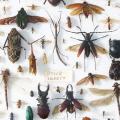
This October there are lots of activities to do in and around Borrowdale, including Barrow House-badge making.
We have some simple plastic badges, with plain inserts ready for you to decorate - we look forward to seeing your designs!
Keswick Museum has a range of activities:
22nd - 30th October 10 - 4: Fun trail to find out more about bats, cats and owls. Included in admission.
Tuesday 25th October 1-3pm: Free 'Big Draw' activity. Make your own Super Sketchbook to fill with drawings.
Thursday 27th October 1- 3pm: Free Halloween Crafternoon. Discover the creepy parts of the collection and create your own spooky masterpiece.
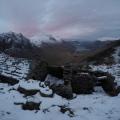
Tim, our new manager, is really excited about seeing snow on the fells! In his excitement he has created some new winter offers, with a code and time limit that will be announced in a mailing at the end of October. So many things to look forward to!



.jpg)

